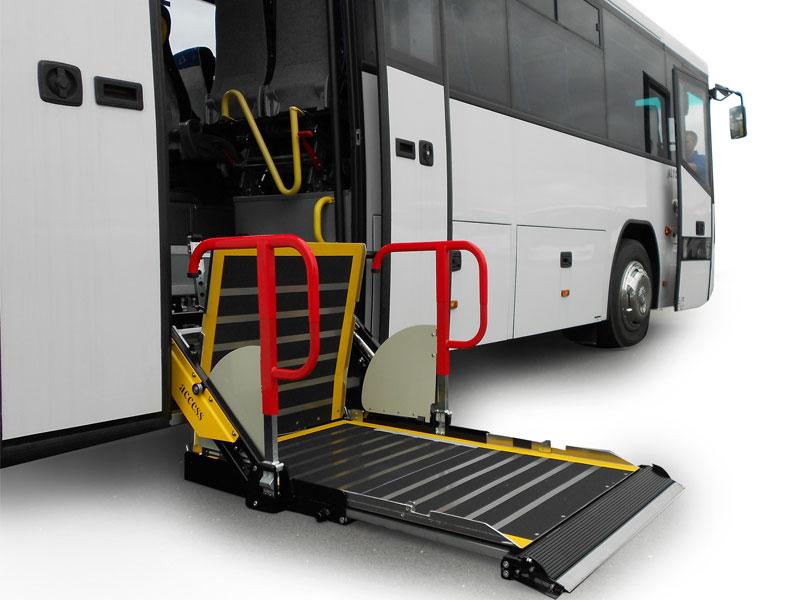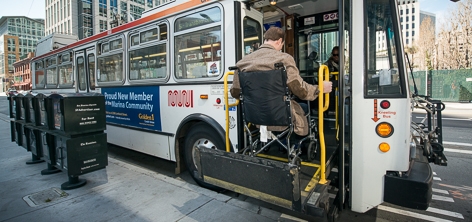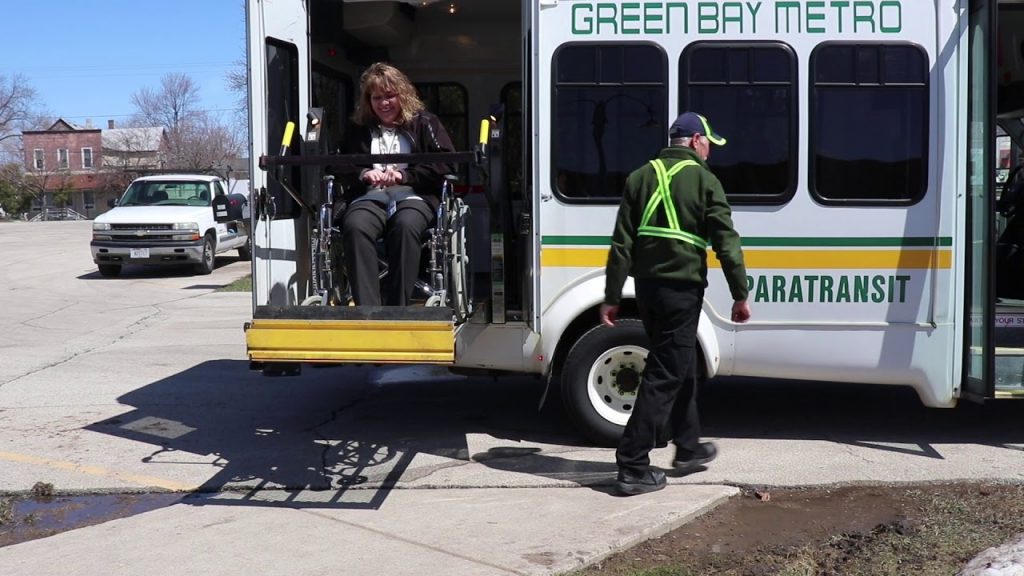In Part I of this series on public transportation I discussed the rules and regulations pertaining to wheelchair users riding the bus and your rights as a passenger. If you’d like to use public transportation as a wheelchair user but cannot ride the regular buses for whatever reason, paratransit may be a useful option for you.
Paratransit can go by many names: Dial-a-Ride, HandyDart (not my favorite name), community transit, MetroAccess. My personal knowledge and experience consists of the system used in the U.S. — therefore, that is what I will be focusing on.
If you’d like to use public transportation as a wheelchair user but cannot ride the regular buses for whatever reason, paratransit may be a useful option for you.

Paratransit Service Areas
It’s important to know that even if your city or county does have paratransit, it might not cover all areas. The rules for which areas they are required to serve are a bit complicated. Let’s start with an explanation from the Code of Federal Regulations:“Imagine a bus route map of a typical city. Color the bus routes and their corridors blue, against the white outline map. In the densely populated areas of the city, the routes (which, with their corridors attached, cut 1 1⁄2 mile swaths) merge together into a solid blue mass. There are few, if any, white spots left uncovered, and they are likely to be very small. Paratransit would serve all origins and destinations in the solid blue mass. But what of the little white spots surrounded by various bus corridors? Because it would make [no] sense to avoid providing service to such small isolated areas, the rule requires paratransit service there as well. So color them in too.”(1)The “corridors” this quote is referring to are the ¾ mile areas on either side of the fixed route (¾ x 2 = 1½) which paratransit is required by ADA law to cover. Additionally, at the very end of a fixed route line it is required to cover a ¾ mile radius. Depending on where you live, paratransit may cover an even wider area than this. Rather than trying to explain all of these lengthy exceptions, you can go here and read section 8.4.2 if you want to get into the finer details. When it comes to figuring out your paratransit’s service area, it would be easier to either call your local transit agency or find a map online.

Imagine a bus route map of a typical city. Color the bus routes and their corridors blue, against the white outline map. In the densely populated areas of the city, the routes merge together into a solid blue mass. There are few, if any, white spots left uncovered, and they are likely to be very small. Paratransit would serve all origins and destinations in the solid blue mass.
Hours of Operation
The paratransit service is required to be available during the same hours as the fixed-route service.(2) This does not necessarily mean that the service will take you anywhere the time the earliest bus in the whole system is operating to the latest. It means that, for example, if you need to go to a hospital, the paratransit would be able to take you there only during the times that the regular bus serves that hospital. If regular buses stop running there at 8pm, then the paratransit will likely stop serving it at 8pm as well. Be aware that the schedule of fixed-route buses can change due to factors such as holidays or certain days of the week such as Sundays, and that certain buses may change their service areas at the beginning or end of a day. Because of these fluctuations of the fixed-route service, every paratransit rider should get to know the regular bus schedule, even if they only take paratransit.
Because of fluctuations of the fixed-route service, every paratransit rider should get to know the regular bus schedule, even if they only take paratransit.
The Benefits of Paratransit
Paratransit systems can be a lifeline if you are disabled – sometimes quite literally. Going to doctor’s appointments or to the hospital for important tests are just one way you can utilize the service. People also go to grocery stores; private homes; parks; libraries; movie theaters; and more. In the past I’ve even taken paratransit to go meet a date, or to a bar to meet friends for drinks (it’s best to not get too tipsy by the end of the night, though – paratransit drivers aren’t designated drivers and they shouldn’t be put in the position of caretaker to a drunken passenger).
Because they work with disabled passengers all day, paratransit drivers, in my experience, are often more comfortable around them than fixed-route drivers, and more knowledgeable about the different types of mobility aids people use and how to secure them. If your pickups stick to a regular routine, drivers who work during those times may get to know you and your specific needs. Additionally, it’s nice to wave at the drivers you know when you see them on the road.
A lesser well-known benefit of paratransit is that it can give you opportunities to socialize with other passengers. People with disabilities are often isolated from each other – we can sometimes go months or even years without connecting to others like us. Some disabled people have never been around other people with disabilities at all. Paratransit rides can provide you a chance to get to know people who may understand you better than most. And of course, you can talk to the drivers as well – except when they are actually driving.
Because they work with disabled passengers all day, paratransit drivers, in my experience, are often more comfortable around them than fixed-route drivers, and more knowledgeable about the different types of mobility aids people use and how to secure them.

Your Local Paratransit
In order to use paratransit services efficiently, you need to get to know the rules and habits of your local paratransit system.
Eligibility
Before you use the paratransit system, you need to go through the eligibility process to see if you qualify. The length of time between your eligibility meeting and when you get approves varies from agency to agency. The eligibility process basically checks for one thing: Are you able to use the regular, fixed-route bus service, or not?
This question can have more than one answer. The eligibility specialist may find that you are not able to use the fixed-route bus during certain times. This can depend on several factors such as variations in your pain or fatigue levels; if your disability is temporary or permanent; if the fixed-route bus stops near your destination are inaccessible to ramps or lifts; and more.
Curb-to-curb or Door-to-door?
Paratransit systems provide two types of service: Curb-to-curb or door-to-door. You need to figure out which type yours provides. At first glance, federal law pertaining to this feels a bit confusing; the Code of Federal Regulations states, “When an ADA paratransit operator chooses curb-to-curb as its primary means of providing service, it must provide assistance to those passengers who need assistance beyond the curb in order to use the service unless such assistance would result in in a fundamental alteration or direct threat.”(3) My interpretation of this is that if you would not be able to use the service unless the drivers assist you when you disembark (for example, pushing your wheelchair up a ramp so you could get to a door), then they must provide that assistance, within reason. If you are able to get to the door on your own, then you must do so. This is different from door-to-door service, in which the drivers will assist you to the door with or without special circumstances.
Same-day or Next-day Service?
Paratransits may offer same-day service if they wish but are not required to do so.(4) If you are curious about the reasons why many do not provide same-day service, check out this article written by Joe Davisca in Metro Magazine called, “Why is no one offering same-day ADA paratransit?” Davisca talks about the reasoning given by some transit agencies, and why he believes same-day service is a better option for both agencies and passengers. The comments on the article add further dimension to the subject. Personally, I’m with Davisca on this one.
What About Personal Care Attendants and Others?
Personal Care Attendants may ride with you, as may individual companions.(5) PCAs are not charged a fare; however, your non-PCA companion is.(6) You may have one non-PCA companion ride with you; you may be allowed additional companions unless doing so would be detrimental to providing service to other eligible disabled people who are riding the paratransit. Additionally, any companions you bring must have the same pick-up and destination as you.(7)
Pickup Windows
A pickup window is a block of time during which vehicles are expected to arrive. Federal Transit Administration rules state that a pickup window be no longer than 30 minutes (some systems may shorten this to 20 minutes). This means that the vehicle will arrive either 15 minutes before or after your pickup time, although some systems place the entire 30 minutes after the pickup time.(8)
When the vehicle arrives at your location the driver must wait at least five minutes for you to show, after which they are allowed to leave. These five minutes cannot begin until the earliest arrival time.(9) For example, if your pickup is scheduled for 3:00pm and there is a 30 minute window (+15/-15 on either side) – meaning your earliest pickup time is 2:45pm – the driver cannot start those five minutes until 2:45pm. Therefore, if your driver arrives early at 2:40pm, they must wait for you at least until 2:50pm (2:45pm + 5 min.). Regardless, it’s a good idea to be ready to go at the earliest pickup time – there’s nothing worse than scrambling around for your housekeys or coat when you hear the vehicle pull up.
Some paratransit agencies may offer a “will-call” service. If you are unsure about your needed return time, you can ask to be put on the will-call list – this means that when you know what time you are ready to be picked up for your return trip, you call the scheduling line and let them know. This is very handy with medical appointments when you often don’t know how long a procedure or appointment is going to take. Still, you may be waiting a while to get picked up depending on how busy the vehicles are. Agencies are allowed to restrict will-call to medical appointments only if they so choose – and they are even allowed to charge a higher rate for will-calls.
Fares
Fares are allowed to be up to twice as much as a comparable ride on the fixed-route bus to your location.(10) If a fixed-route ride from Monterey to Carmel costs $1.75, the highest the paratransit agency can charge is $3.50. Since fixed-route bus lines often scale their fares to the length of the trip, you may encounter some paratransits that charge by length of the trip as well. For example, an agency may say that a trip between two miles and five miles costs $2.50.
Service Animals
Service animals are permitted on paratransit vehicles; this does not include emotional support animals. Service animals are allowed even if the driver or other passengers are allergic to them. Paratransit agencies are not allowed to ask for documentation for your animal. Drivers are allowed to choose not to transport you if your service animal is a direct threat to health and safety, i.e., a dog that tries to bite or is not housetrained.
Sometimes your service animal cannot fit on a lift with you or gets very anxious about being on the lift. My service dog is large, and he cannot fit with me. The system I have worked out is to hand the leash over to the driver who holds it until I am in the vehicle, then the driver will bring him inside through the front door. I feel a bit anxious handing him over, but it is usually for less than a minute.
Tips and Tricks
Dress for the weather because you may arrive early before a business or facility opens or be picked up later after a business or facility closes.
Keep track of which medical offices are OK with you being a bit late and which ones aren’t. Unfortunately, your paratransit system may have a habit of dropping you off late, in which case you should try to get an earlier time than is suggested by your scheduler.
In the same vein, get to know your local paratransit’s habits. Are they generally on-time or late, and does this change based on time of day? How long do rides usually take? Do drivers find pickup addresses well? When scheduling a ride, when is the best time to call, i.e., when are the lines less busy? These things are often only learned by experience.
Paratransit issues or complaints
Many times, issues will not be fixed until someone speaks up about them. (The most common issues I’ve run into – and one that seems to be common elsewhere – is late pickups.) If you use your local paratransit and experience issues, you can try submitting a complaint to your local transit authority. If you can, look for an ID number on the vehicle and/or your driver’s name. Record the time and date of the incident. Whether you submit a complaint online or over the phone, be sure to get some sort of confirmation number or the full name of the person you spoke to and record the day and time you made the complaint. Do not simply tell the driver your complaint in the moment – they likely won’t have the authority to fix it nor do they make the schedules. Sometimes they are overworked and their schedules are packed, and just like you they may be frustrated when they are late, too. If you feel a very serious issue has occurred, you have been discriminated against, or that the paratransit system has broken one of the laws I’ve talked about here (or others), I encourage you to lodge a complaint with either the Federal Transit Administration or the U.S. Department of Justice:- FTA complaint form (PDF) – Send to FTACivilRightsCommunications@dot.gov and put “FTA complaint form” in the subject line. They also the request the following in your email or on a separate sheet of paper:
- A summary of your allegations and any supporting documentation.
- Sufficient details for an investigator to understand why you believe a public transit provider has violated your rights, with specifics such as dates and times of incidents.
- Any related correspondence from your transit provider.(11)
- File and ADA Complaint With the Dept. of Justice – This link provides an electronic form as well as an option to mail-in. It also has a FAQ including what happens after your complaint is received and how to request accommodations if you cannot write or need to use sign language, and more.
Resources
- Rider’s Guide to Public Transit for People With Disabilities – A comprehensive PDF guide that includes many different disabilities as well as more information on your ADA rights.
- Become and ADA Paratransit Pro – A video guide for PACE paratransit, a system from Chicago. (6 min.)
- Booking a Ride with HRT Paratransit App – A video from Hamptons Roads Transit, Virginia. Some systems are more technologically advanced than others. (1 min.)
References
- Federal Transit Administration. (2015). Americans With Disabilities Act (ADA): Guidance. FTA C 4710.1. ch. 8, pg. 8-8. Retrieved from: https://www.transit.dot.gov/sites/fta.dot.gov/files/docs/Final_FTA_ADA_Circular_C_4710.1.pdf
- Federal Transit Administration. (2015). Americans With Disabilities Act (ADA): Guidance. FTA C 4710.1. ch. 8, pg. 8-7. Retrieved from: https://www.transit.dot.gov/sites/fta.dot.gov/files/docs/Final_FTA_ADA_Circular_C_4710.1.pdf
- Code of Federal Regulations. Title 49. Title 49, Subtitle A, Part 37.3. Retrieved from: https://www.ecfr.gov/current/title-49/subtitle-A/part-37
- Federal Transit Administration. “May I change my drop-off location on complementary paratransit service the same day?” (n.d.). Retrieved from: https://www.transit.dot.gov/may-i-change-my-drop-location-complementary-paratransit-service-same-day
- Code of Federal Regulations. Title 49. Title 49, Subtitle A, Part 37.123, sec. f, paragraph ii. Retrieved from: https://www.ecfr.gov/current/title-49/subtitle-A/part-37
- Federal Transit Administration. (2015). Americans With Disabilities Act (ADA): Guidance. FTA C 4710.1. Ch. 8, pg. 8-17. Retrieved from: https://www.transit.dot.gov/sites/fta.dot.gov/files/docs/Final_FTA_ADA_Circular_C_4710.1.pdf
- Code of Federal Regulations. Title 49. Title 49, Subtitle A, Part 37.123, sec. f, paragraph ii. Retrieved from: https://www.ecfr.gov/current/title-49/subtitle-A/part-37
- Federal Transit Administration. (2015). Americans With Disabilities Act (ADA): Guidance. FTA C 4710.1. Ch. 8, pg. 8-13. Retrieved from: https://www.transit.dot.gov/sites/fta.dot.gov/files/docs/Final_FTA_ADA_Circular_C_4710.1.pdf
- Federal Transit Administration. (2015). Americans With Disabilities Act (ADA): Guidance. FTA C 4710.1. Ch. 8, pg. 8-20. Retrieved from: https://www.transit.dot.gov/sites/fta.dot.gov/files/docs/Final_FTA_ADA_Circular_C_4710.1.pdf
- Code of Federal Regulations. Title 49. Title 49, Subtitle A, Part 37.131, sec. c, part 2. Retrieved from: https://www.ecfr.gov/current/title-49/subtitle-A/part-37
- Federal Transit Administration. “File a Complaint with the FTA.” (Aug 17, 2021). Retrieved from: https://www.transit.dot.gov/regulations-and-guidance/civil-rights-ada/file-complaint-fta
- Federal Transit Administration. “May Personal Care Attendants (PCAs) ride for free on complementary paratransit and fixed route?” (n.d.). Retrieved from: https://www.transit.dot.gov/may-personal-care-attendants-pcas-ride-free-complementary-paratransit-and-fixed-route

